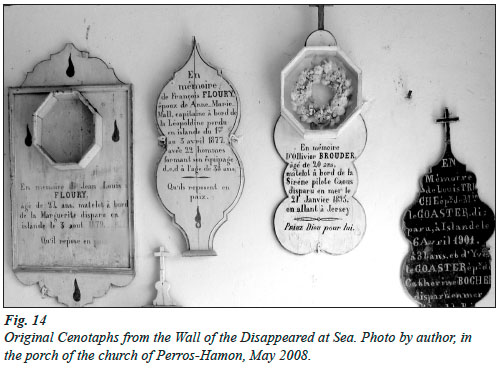Articles
Narratives, Images and Objects of Piety and Loss in
Brittany
Maura CoughlinNew York University
Résumé
Comment les études en culture matérielle peuventelles offrir de nouvelles perspectives sur l’étude de l’art de la fin du XIXe siècle en France ? Comment le travail d’artistes contemporains peut-il animer une collection d’objets historiques et particuliers à un lieu donné ? Cet article s’attaque à ces questions au moyen d’une lecture attentive d’une installation à Saint-Brieuc, de pair avec les collections de deux écomusées en Bretagne et de plusieurs autres sites historiques, sous l’angle des politiques de la présentation et de la commémoration. Il fait entrer plus intensément ces collections dans un dialogue au sujet des sites historiques, des photographies et des peintures des rituels religieux de la fin du XIXe siècle en Bretagne, qui se concentrent sur les rituels quotidiens de la mémoire et du deuil.Abstract
How can material culture studies offer new perspectives on the study of late-19th-century art in France? How can the work of contemporary artists animate a collection of historical and locally specific objects? This paper takes up these questions by a close reading of an installation in Saint-Brieuc, along with the collections of two ecomuseums in Brittany and several other historical sites in terms of a politics of display and commemoration. It further engages the collections in a dialogue about historical sites, photographs and paintings of religious ritual in late-19th-century Brittany that focus upon everyday rituals of memory and mourning.1 This essay addresses the interplay and intermingling of objects, art and visual culture in several museums and historical sites dedicated to local social history in Brittany in the northwest region of France. Specifically considered is the ways in which cultural institutions present material and visual culture so as to represent bodily experiences of loss, longing and the performance of mourning and in so doing how they construct and reiterate regional, local and provincial identities for Brittany’s past. Apart from museological distinctions and the cultural politics of decentralization, my interest is in the narration of place that occurs in these spaces—in the presentation of a particular and narrow range of objects and images relevant to collective cultural heritage. Rather than draw hard (and somewhat arbitrary) lines between folk or ethnographic museums and fine arts museums, I want to examine the relevance of materiality to the discourse of realism in late-19th-century art and the ways in which museums of cultural heritage encourage mutually reinforcing narratives of images and things. This is to say that my interest is in using material culture studies to inform a study of visual culture, particularly that of a rural nature.
2 With this approach, the display of a material object alongside a visual representation has critical weight. It is not merely a social trace that confirms or denies the constructed nature of a representation. Conversely, I query the ways in which visual culture is introduced in ethnographic displays as either backdrop to, or authentication of, objects and their past uses. Two ecomuseums in Brittany—the Écomusée des vieux métiers de Lizio (Museum of Old Trades of Lizio) and the Écomusée de l’Ile de Ouessant (Techniques and Traditions of Ouessant)—are at the heart of this meditation on images and things. The choice of these two small museums does not suggest they represent all options or even opposite ends of the ecomuseum1—however they offer very different approaches to a subject of my research: the material culture of women’s piety, memory and mourning at the turn of the 20th century.
3 In May, 2008, I arrived at Saint-Brieuc near the north coast of Brittany after travelling around the region by train and car to visit many of the small archives, departmental museums, urban museums, ecomuseums and sites that had inspired artists and writers during the later 19th and early 20th centuries. As an art historian I am fascinated by the ways that local museums in France display painting, photography and other forms of visual culture side-by-side with artifacts of material culture relevant to the region. Established in 1886, the Saint-Brieuc Musée d’art et d’histoire des Côtes d’Armor (Museum of Art and History) is a case in point. The shared focus of art and history, declared by the title of the Saint-Brieuc museum is expressed in its layout: its two exhibition spaces are devoted to life in the Côtes d’Armor region and to temporary exhibitions of art and visual culture. The strength of regionally-focused institutions such as this is their attention to the articulation of place, as opposed to an emphasis on selling the notion of artistic singularity and avant-garde genius like the blockbuster-dependant national museums in major urban centers do. Although 19th- and early-20th-century artists in Brittany have a strong presence in national art collections such as the Post-Impressionist galleries of the Musée d’Orsay in Paris, smaller venues and regional museums marshal prominent as well as lesser known artists and other forms of visual culture to address the issue of "place."2
4 The Saint-Brieuc Musée d’art et d’histoire des Côtes d’Armor is a municipal museum that, at the time of my visit, was hosting an exhibition entitled France-Estonie/Je ne me souviens de rien (Figs. 1-3). The exhibit was an installation and intervention by Keret Altpere, a contemporary textile artist from Estonia who was serving a residency in Côtes d’Armor. Her residency had a very specific purpose3 formulated by the Office Départméntal de Développment Culturel des Côtes d’Armor in collaboration with numerous local partners.4 As Altpere explained to me in correspondence of August 2009, every other year a textile artist is given a residency in order to work on artistic projects related to the history of Brittany’s former linen industry (Toiles de Bretagne), an industry that flourished from the 17th to 19th centuries. This was a global operation that imported linen seeds from Baltic States and grew, spun and wove linen in Brittany that was exported as finished fabric to Latin America. Little material evidence of the industry remains, apart from the intangible memories of the local people and the tangible manor houses of the textile merchants. The residency project was charged with putting contemporary art at the heart of rural life by encouraging contact between a foreign born artist and the local population, to explore local history and to allow the artist to work in another cultural environment and to find sources of renewal for her art.
Fig. 1 Sample of textile work by Keret Altpere. Photo by the author.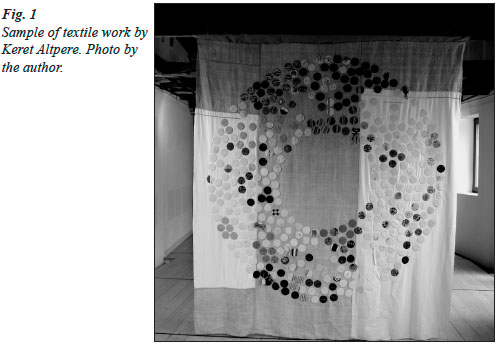
Display large image of Figure
1

Display large image of Figure
2
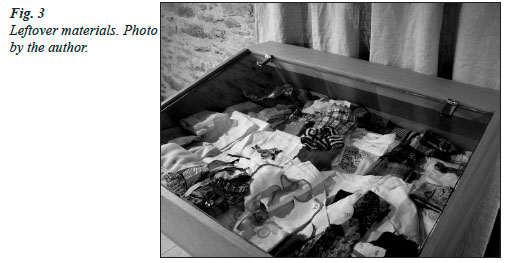
Display large image of Figure
3
5 From the museum collection, Altpere selected a group of jacquard looms in the upper levels of the historical displays and inserted her own work into the town’s past. In the darkened rooms on the lower level, she assembled quilts and other mixed-media pieces from fragments of evocative fabrics that connected the place of her birth and her residency in the Côtes d’Armor. Her textile and mixed medium works were accompanied by sound installations: recordings of memories from inhabitants of the Breton village of Saint Thélo and from her great-grandfather’s village of Mõisaküla on the island of Saaremaa, Estonia. Altpere’s use of everyday textiles not only referenced her travels and understanding of distance, but also encouraged visitors to experience the collection and her contributions through their own geographic displacements. As a viewer I was inspired to spin my own travels within Brittany—from metropolitan centers to villages to countryside to historical sites to archives to museums—into a subjective, performative web of unending associations of place, travel and cultural tourism as Crouch and Desforges would say (2003: 6-7).
6 On visiting Saint-Brieuc I thought about American author Marilyn Robinson and how, in her novel Housekeeping, she frequently muses on the evocative life of things past. In one eloquent passage, her narrator imagines an assemblage recuperating all that had been lost in the lake that dominates the novel’s fictional town of Fingerbone. Such a net, such a harvesting, would put an end to all anomaly. If it swept the whole floor of heaven, it must finally, sweep the black floor of Fingerbone, too. From there, we must imagine, would arise a great army of Paleolithic and neolithic frequenters of the lake—berry gatherers and hunters and strayed children from those and all subsequent eons, down to the earliest present, to the faith-healing lady in the long, white robe … to the farmer … Add to them the swimmers, the boaters and canoers … There would be a general reclaiming of fallen buttons and misplaced spectacles, of neighbors and kin, till time and error and accident were undone, and the world became comprehensible and whole. (Robinson 1980: 91–92)Regional museums, and ecomuseums in particular, are positioned to present a range of objects from a place’s past that evoke narratives from their curators and spectators alike. A museum cannot, of course, reclaim every lost bit of materiality, nor could it hope to make the past utterly whole and comprehensible. Yet, the appeal of so many historical collections—and their accumulated and enshrined objects of the everyday—does indeed depend, to some degree, on this unspoken promise. Philosopher of the everyday, Michel de Certeau (1984) and cultural anthropologist Tim Dant (1999) suggests that we form lived and embodied relationships with material objects. However, can we discuss the relationships without necessarily dismissing them as framed by nostalgia, imposed from outside authority, or generalized by international or global culture?5
7 Unlike obsessive hoarding or the inability to throw anything away, ethnographic collecting generally privileges objects that have been categorized as "Other" from present, everyday time and from the cultural place of the museum. Things are chosen for their representative or exemplary qualities, for their abilities to stand for another era, place or attitude toward material culture. Museums often make efforts to reconstruct the past lives of objects through textual description, sound environments or the reproduction of contextual "background" images such as vintage photographs, postcards, prints, posters or paintings. For example, in Saint-Brieuc, a glass case containing a colporteur’s box whose drawers are brimming with late-19th and early-20th-century religious souvenirs, displays an enlarged version of a photographic postcard image of a souvenir vendor (Figs. 4, 5) at a large-scale, outdoor religious event held in the summer that Cariou and Le Stum (1997) refer to as a pardon.6 Nearby are tiny religious tableaux inside bottles (made by sailors from match sticks), and a Breton hooded black mourning cloak, hanging ghost-like within the case, hinting of its past use and wearing. The display generates more questions than it answers. What can such objects narrate? What is the point of looking at religious material culture that has so clearly gone out of use? Why have these particular objects been saved and presented? From whose collection did they come? Are we to believe that sailors made only pious objects over the course of long sea journeys? Whose hierarchy of "stuff" has designated the objects that make it into display spaces as "authentic" links to the past?
Fig. 4 Display case in Saint-Brieuc, May 2008.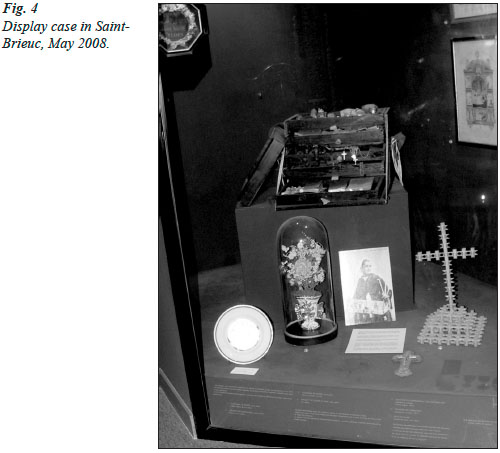
Display large image of Figure
4
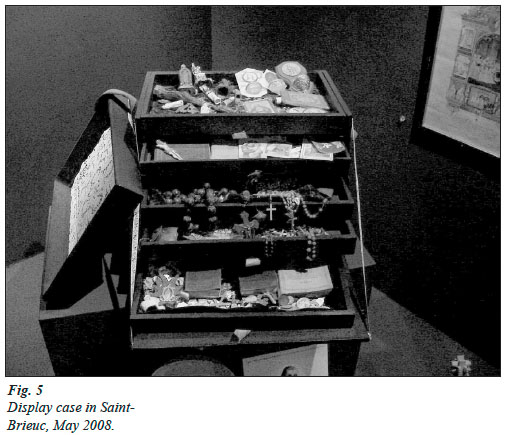
Display large image of Figure
5
8 Popular religious objects (like those in the heap at Saint-Brieuc) have little monetary value, yet their accumulation and presentation seem to mark them as significant generators of historical narrative, as material collected rather than rejected as obsolescent waste. Popular culture associated with the religious revival in France has long engendered a masculine modernist recoil from its kitsch popularity and proliferation (Kauffman 2005: 64). Realist literature abounds with instances in which the consumption of religious popular culture is denounced as false, fetishistic or kitsch. Gustave Flaubert’s fictional character Emma Bovary, for example, embodies the female consumer of popular culture, whether it be the bourgeois journal L’Illustration or the lachrymose chromolithographs that instruct her childhood as she "looked at the pious vignettes with their azure borders in her book, and she loved the sick lamb, the sacred heart pierced with sharp arrows, or the poor Jesus sinking beneath the cross he carried" (Flaubert 1904: 44). The impulse to categorize women’s relationships with material culture as excessive and fetishistic can be read as a particularly modernist cultural pattern that reinforces binary divisions of class, gender and national identities while opposing "high" and "low" forms of culture. In my work on rural women’s material culture of piety and representations of it (Coughlin 2009), I have moved away from these binary options of categorizing cultural forms, preferring instead to research the use of such images and objects by women in Brittany for the ways in which they enabled performances of local identity and provided forms of resistance to the homogenizing forces of modern consumerism and the institutional packaging of everyday experience.
9 In an unpublished paper, sociologist Eva Persson (2007) discusses the problematic material nature of religious images and objects in Irish Catholic families.7 Persson finds that these things, even when no longer given a position of honour in the home, are difficult to dispose of and thus, are often moved into out-of-the-way locations, but may eventually find a home at a religious site such as a wayside shrine or holy well (Fig. 6). At Saint-Brieuc, I wondered, was the municipal museum serving a similar function for religious bric-a-brac? Can its use by the community be understood as a site for the recuperation of devotional waste? Did or does it serve the role of recycling this past? What narratives along these lines does the display promote?8
10 To consider the function of museums in generating narratives of the local from material culture, one must turn to recent museological attitudes and models. The framing of ethnographic material culture in museums began to receive radical critique by contemporary artists such as Christian Boltanski in the late 1960s. Writing about his work, Rebecca DeRoo (2004) sees Boltanski’s ideas as being in dialogue with the notion that "in an ethnographic museum … unlike in an art museum, utilitarian objects and photographs were understood as evidence and as providing an authentic picture of the past … as exemplary of the culture" (228). Also espousing the post-1968 cultural turn of "new museology," the ecomuseum was developed in France with the goal of opening up natural, living cultural heritage to a broader spectrum of society (Davis 1999: 54). In 1971, Hugues de Varine coined the term "ecomuseum," (écomusée) referencing an environmental concept of "écologie" (Davis 2005: 370) As a democratizing approach to cultural heritage, the ecomuseum was proposed as an inclusive alternative to state run, bureaucratic, centralized, professionally curated and often elitist institutions (Blockley 1999: 24-25). In one of its most radical formulations, in 1984, Québécois Museum administrator René Rivard characterized these relationships: "traditional museum (= building + collections + experts + public) to the ecomuseum (= territory + heritage + memory + population)" (Davis 2005: 371). In an influential manuscript often cited in later texts on the ecomuseum, Rivard (1984) makes a radical call for "repersonalizing" the local with a museum of living, collective memory (rather than the "temporal vector" of the valorized past) that in its more extreme assertions has "no need for specialization, historians, folklorists or nostalgic or callous tourists" (1984: 45-46).
11 As it was theorized, the ecomuseum had a somewhat utopian scope: it was to be broad enough to encompass a natural and cultural landscape, local heritage, dialects and sense of place, along with the objects, archives and images that might be contained in a building (Davis 2005: 368)—the kind of place "where a multiplicity of voices can be heard and … where dialogue can take place" (Corsane 2005: 9). The ecomuseum was to providea mirror in which a population could seek to recognize itself and to explore its relationship to the physical environment as well as to previous generations; also an image offered to visitors to promote a sympathetic understanding of the work, customs and peculiarities of a population. (Poulot 1994: 66)An ecomuseum’s success was to depend upon community agreement, support and involvement; it promised to give back to the community by retaining local character, fostering sustainable businesses, promoting festivals and thereby aiding the economic regeneration of rural areas, in part through cultural tourism. What differentiates the ecomuseum from sites of staged heritage tourism is that the ecomuseum’s focus must be determined by its local population as opposed to being imposed from the outside (Davis 1999: 69). The ecomuseum is thus a way of producing, performing and maintaining a sense of place or locality. As geographer Doreen Massey (1991) explains, our contemporary understanding of a certain place or locality is the result of many intersecting social relations that are always in process of reproducing an ever-changing specificity (28). The first official ecomuseums in France were connected to the establishment of the Parc Naturel Régional d’Armorique in Finistère (Western Brittany), and one of these was the Écomusée de l’Ile de Ouessant that eventually included two houses, a lighthouse and a windmill. Many ecomuseums, likewise, encourage the visitor to make contact with various "antennae" sites in the landscape that inform an intangible sense of place that the museum aims to conserve and promote (Davis 2005: 368).
Fig. 6 Accumulated votive "gifts" at St. Brigid’s Well, Liscannor, Co. Clare, Ireland, June 2007.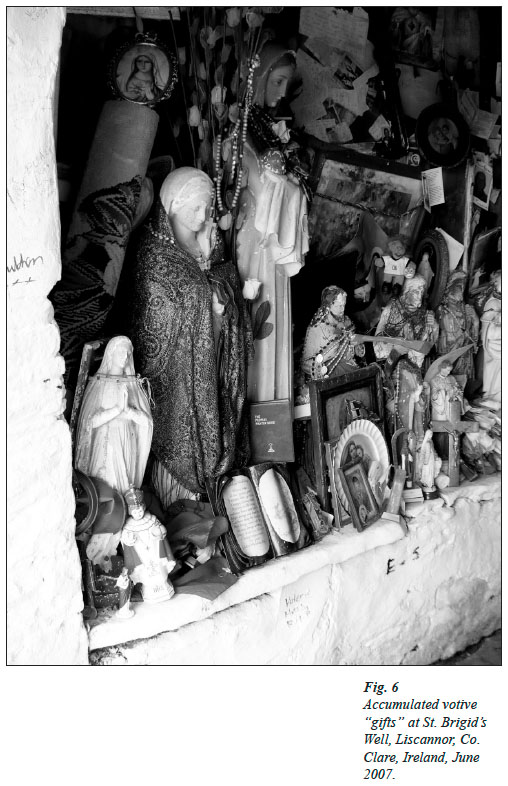
Display large image of Figure
6
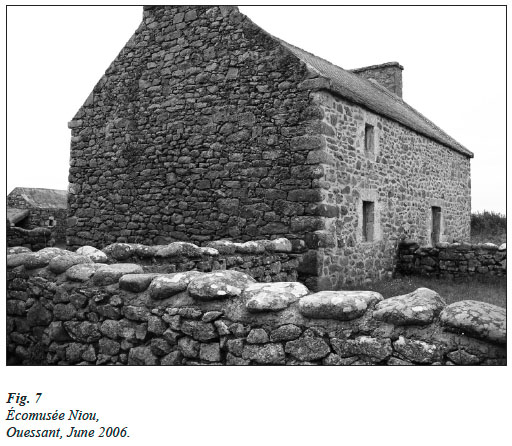
Display large image of Figure
7
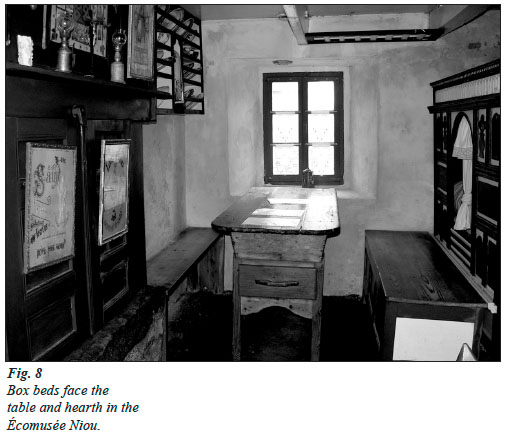
Display large image of Figure
8
12 La Maison du Niou Uhella (Fig. 7) the "premier ecomuseum of France" (Davis 2005: 368) opened in July of 1968, prior to the invention of the category. This building, in the tiny hamlet of Niou Uhella on Ouessant later became the centrepiece of the Écomusée de l’Ile d’Ouessant. It is a slate-roofed, stone cottage, in which compartmentalized spaces of two rooms served as kitchen, dining room and bedroom are typical of house styles ca. 1900 (at about this time of relative prosperity, many families replaced thatch roofs with slate (Péron 1994: 32)). Connected to the house is a small museum, displaying in glass cases objects and costumes from the history of the island. The trim, walls and furniture are painted white and bright blue—a colour with Marianic overtones, favoured at about this time. As historian Françoise Péron (1997: 200) notes, the interior is arranged like a boat, but ornamented like a chapel: small passages of living space weave through the box-beds, armoires and enclosed hearth (Fig. 8). Overhead are suspended colourful reflective glass balls. The hearth is surrounded by pious images such as statuettes and popular Epinal and chromolithographic prints (Simon 1997: 265). These devotional prints were cheaply printed by the thousands in large publishing houses in Rennes and Quimperlé and were sold at pardons and by travelling merchants. A standard format for these prints has an iconic image of a saint surrounded by smaller narrative images of miracles, devotional texts and blessings (Pocius 1979: 132-34). Locally significant saints who were the focus of major Breton pardons include Saint Yves (of Tréguier), patron saint of widows and orphans, and Saint Anne, patron saint of sailors (local legends tell of her birth in the port town of Douarnenez (Anson 1965: 69)). At home, these prints blessed the hearth and protected the family, gaining meaning by the ways in which they were displayed and consumed (Dant 1999). For a population with a very low rate of literacy (Ford 1990) images like this were important mnemonic markers that could return the viewer to a significant event (for instance the pardon where the print was purchased) and serve as a continual reminder of his or her spatial and performative experience of a festive event (Edensor 2000; Crouch and Desforges 2003: 6). The pardon souvenir might interact with everyday life and thus bridge spatial and temporal distances for the former participant (and other viewers).
13 As suggested by the Niou reconstruction, elaborate domestic altars in coastal homes were the meeting place of private loss and global travel (Simon 1997). Here, on the open dish racks on the walls, marriage globes and devotional statues are sandwiched between dinner plates and exotic colonial souvenirs brought back from men’s travels at sea. The minimal "male" intervention in the interior of the home is telling of the general absence of men from everyday life on the island: men and boys shipped out frequently for voyages of six or seven years. The reconstructed decor and layout of the domestic space is a bit simpler, cleaner and more prosperous looking than a widely read travel account written in 1895 would have us believe. The narrator, Victor Eugène Ardouin-Dumazet, describes a typical Ouessantine cottage as having granite mortarless walls, a straw roof, a beaten earth floor, only a few kitchen utensils, a meager fire made of gorse twigs and dried cow droppings, very little light and close, humid smells that came from a family sharing one enclosed bed (1895: 287).
14 By contrast, L’ Écomusée des vieux métiers de Lizio (Morbihan, Brittany) (Figs. 9, 10) contains within a 2000 square metre building a collection of more than 70,000 objects relating to the materials and techniques of everyday life. If one compares the reconstructed interior of Niou to one in Lizio, Niou appears almost modernist in its relatively uncluttered sparseness. Both interiors are ornamented with religious popular images, but a great deal more horror vacui is at work in Lizio. The resulting historical reconstruction of domestic space is not at all similarly aestheticized. Lizio’s ecomuseum was founded (in 1985) and is maintained by a ceramicist, Alain Guillard (the current large structure opened in 2000). Guillard’s website promises visitors "a lesson on the past" of "artisans and other trades" that offers not only obsolete gadgets, garments and gear, but an evocation of skills and gestures lost to the present.9 The displays are wide ranging: more than 60 mise en scènes staged in the rambling building include an automotive garage from the 1950s, part of a cinema interior, a classroom, a grocery store, tobacconist, pharmacy, a toy shop, several home interiors and the workshops of various rural artisans. The result more resembles dealers’ stalls at the Porte de Clignancourt flea market on the northern edge of Paris than an official French museum. Its overstuffed accumulation, while offering unintentionally marvellous, creepy and macabre tableaux animated by wigged mannequins and plastic dolls in period costume, seems to suggest that all materiality of the past merits saving, and that all can be made comprehensible and whole.
15 Yet it may be that by enshrining this past in such a mad inventory, the death or obsolescence of it is ensured. (Why have one Banania tin when thirty-five will do the job more effectively?) Before his execution in 1944, Annales historian and economist Marc Bloch condemned the Vichy government’s peasant populist policies as creating "vast junk museums" (Poulot 1994: 70). This is a sentiment echoed by Rivard, who cautions against a tendency toward muséomania: the enshrining of every last thing that goes out of usage (1984: 44). Rather than representing a place or landscape, Lizio’s massive excess seems to represent, more than anything, one person’s passion for accumulating things. Marketing scholar, Russell Belk has written extensively on the phenomena of collecting in consumer society, which he distinguishes from "mere stockpiling or warehousing, mean acquisition, or sheer accumulation" (1988: 549). Guillard’s manic hoarding of the past in Lizio does not so much make it comprehensible, as it seems—almost inadvertently—to parody contemporary rational, professionally curated spaces of museum display, such as the costume and everyday life sections of the Musée de Bretagne in Rennes and the Musée Départmental Breton in Quimper.
Fig. 9 A Breton interior at the Lizio Ecomuseum.
Display large image of Figure
9

Display large image of Figure
10
16 Today, in the Musée de Bretagne—housed in the postmodern Champs Libres center in Rennes—traditional Breton festive costume is displayed in brightly lit vitrines, on silver mesh supports, accompanied by bilingual explanations of the date, materials, function and specifically local origin of the garments. A nearby display combines an undated reliquary with a few turn-of-the-century women’s fancy pardon pins (épingles de pardon) and provides text that again explains the place of manufacture and use of the latter. An early-20th-century travel poster with a stylized rendering of a Breton pardon hangs behind these objects, encouraging the viewer to imagine a person’s travel to the pardon, the lure of contact with the sacred (the relic) and the act of consumption: the souvenir brought home (these pins were often bought at pardons and given as engagement presents). Rennes thus situates its representative objects in the context of the French religious revival ca. 1880-1920 and the local culture of pardons in Brittany. In his discussion of the politics of Breton heritage, historian Patrick Young (2009) writes of the attraction of traditional costume for tourists to Brittany in the early 20th century. He suggests that after the turn-of-the century—a time he refers to as hospitable to folkloric display—the Breton museum was able to "to consolidate its importance as a central repository for Breton patrimony and a key regional attraction" (635). He further observes that during the 1920s and 1930sBrittany had become one of the more richly endowed regions in terms of its formal and less formal collections of popular and religious art, folkloric materials and costume; these "artifacts" were often culled from local areas and assembled into collections for public display either in museums or in parts of churches and chateaux. (635-36)Among the holdings of both Lizio and Niou are collections of objects called marriage globes. These personal collections, essentially miniature museums, are arranged beneath a blown glass dome. The assemblages may include a range of important material traces of a life including fragments of wedding costumes, locks of a dead child’s hair and other loaded, apotropaic and symbolic items. Wreaths of flowers at the heart of the globes came from a bride’s crown, making the globe a meeting place of the body and object, narrating a personal history through a collectively understood language of things. As reliquaries of the commonplace rather than the sacred, the globes’ contents are marked by bodily presence and traces of social interaction. These are not timeless objects of "primitive peasant culture" but objects with histories that changed over time. As literary critic Susan Stewart writes, souvenirs of individual experience tend "to be found in connection with rites of passage (birth, initiation, marriage and death) as the material sign of an abstract referent … [s]uch souvenirs are rarely kept singly; instead they form a compendium which is an autobiography" (1984: 139). Before the practice ceased in the mid 20th century and globes thereby became collectible (yet unmarked) antiques of a bygone era, the marriage globe had no intrinsic value outside of the family.
17 The ecomuseum of Lizio presents its collection of marriage globes (Fig. 11)—both in its packed display spaces and on its website—accompanied by explanatory texts that outline the specific iconography of flowers, mirrors, porcelain angels, gilded metal and small birds and the ways the combination of these objects might narrate a biography of the woman who assembled it. In Lizio, amid hat boxes, ancient sewing machines, coffee tins and bicycles, the group of marriage globes no longer seem to speak to individual experience: they demonstrate a range of types marked by continuity of arrangement and variation of detail. Like the material fragments enshrined in a reliquary, the dusty contents today seem to have, to use the words of historian Patrick J. Geary (1995: 174) "no obvious value apart from a very specific set of shared beliefs … once removed from their elaborate reliquaries or containers, they [are] not even decorative." Having been removed from the everyday world of personal experience—wherein the contents functioned mnemonically—to the world of the collection, marriage globes have become unmarked curiosities, presented to visitors as enigmatic (and somewhat useless) things from times past.
Fig. 11 Marriage Globes, Lizio, May 2008.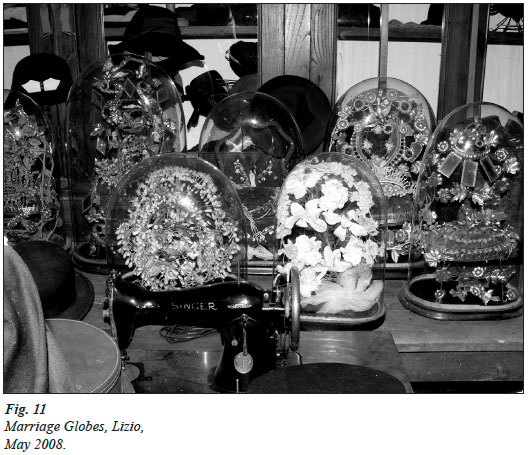
Display large image of Figure
11
18 At the Niou ecomuseum on Ouessant several
globes are displayed. As they might have in a past era, two sit on mantles in the
reconstructed cottage (ca. 1900). The shelves, above or near the hearth, served as
informal family altars that were meeting places of women’s local culture of piety (in
images of local saints and local pilgrimage mementoes) and the exotic souvenirs brought
home by the family’s (male) global travellers. Several other globes are displayed in cases
in the historical museum at Niou that adjoins the period-piece cottage. In the glass case,
housing one display of globes, is a reproduction of a painting by French painter Charles
Cottet, Wake of a Dead Child on Ouessant (1897) that appears to bear witness to a
social context and ritual function of the object (Fig. 12). The text beside the
reproduction of Cottet’s painting reads:Death Rituals
Between
the moments of a newborn’s birth and baptism, it is continually watched over. But after
baptism, the young child’s salvation is certain. This is why the death of a very young
child, so common at this time, was not considered as a tragedy. The tiny corpse was
dressed in a colored silken gown topped by a second gown of lace. Colored paper flowers
were fastened to this. A branch ornamented with ribbons was placed on his head. The next
day he was taken to be buried in a casket that remained open until the last moment of
descent into the tomb, and after having already taken a lock of hair and some of the
ornamental funerary flowers that would be placed in a reliquary in the home. The painter
Cottet, at the turn of the last century preserved a memory of this serene ceremony in
several canvases, one of which is in the collection of the Fine Arts Museum of
Quimper.10
In
this painting, Cottet depicts two wedding globes beside the ornamented body of an infant
in the material context of a wake for a dead child that we are told Cottet witnessed on
Ouessant (Cariou 1988: 124). The social objects arranged around the corpse suggestively
align across a range of bodily experiences and serve specific cultural meanings. If we
believe that Cottet’s painting originates in an observed mourning practice, then we must
assume that the globes do more than decorate the display of the dead child that is being
waked: they seem to be part of a process of connecting the child’s dead body to a material
history of the family and thereby making the process of mourning possible, while marking
the body’s transition from recently animate to inanimate. Heightening the composition’s
effect of "stilled-life," the tiny corpse is framed by lit candles and the dead world of
the globes. For the body only recently rendered lifeless, death is tragically confirmed
and uncannily made present. Attention to the material effects the transformation: white
linens cover walls and windows; domestic space is thereby purified and the mundane
function of the dining table is transformed to the corpse’s space of presentation (Badone
1989: 62).
19 The text at Niou (quoted above) speaks of the banality of infant mortality in the late 19th and early 20th century, a time when such loss was more acceptable and representable. Historian of the island, Françoise Péron (1997) reiterates the ecomuseum’s assessment of Cottet’s painting, that the death of an infant was not a sad affair at the time, as he or she was ensured to go straight to heaven. She also tells us that this attitude on the part of the Islanders seemed monstrous to outside observers (222). In its presentation of the material culture of death, mourning and memory, the Niou ecomuseum displays its marriage globes both as objects that bore material witness to crucial moments in the life of the family, and as objects that served to represent Ouessantine customs to the outside world.
Fig. 12 Charles Cottet, Wake of a Dead Child on Ouessant (1897) Quimper Museum of Fine Arts. Photo by author, October 1997.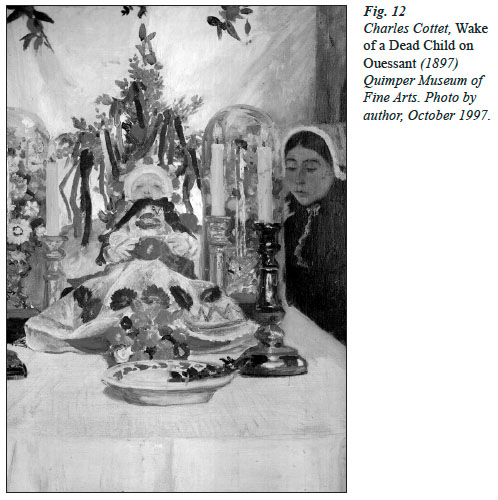
Display large image of Figure
12
20 Cottet’s paintings from this series do not seem to be portraits of individuals: when they were exhibited as rural "types" in Paris, they produced a great deal of shock from critics who found them barbaric, crudely coloured and insufficiently sad. Art historian Linda Nochlin (1971: 82) characterizes the prosaic nature of realist representations of death and religious ritual with Courbet’s famous declaration: "I cannot paint an angel because I have never seen one." Nochlin writes that the realist approach to the death of an individual treats it with "the banal level of mere commonplace, everyday actuality" (1971: 58). Just as a mummy encountered in a museum is inherently uncanny, here a formerly animate body has become a thing, and its strangely festive ornamentation underscores the material transformation. Cottet’s insistence upon the material actuality of the child’s body echoes the attitude of his realist forebear Gustave Courbet, who famously declared, "painting is essentially a concrete art and can only consist of the representation of real and existing things. It is an entirely physical language, that uses for words, all visible objects."11 Breton-born critic Gustave Geffroy comments on the strange materiality of Wake of a Dead Child on Ouessant, that an image of childhood cut short ought to generate an emotional response in the viewer, but this child’s body inappropriately recalls a shop’s display of cured meat or a candied form of Jesus to be sold (and consumed) at Christmas (1900: 99).
21 Whether or not Cottet, the "outsider" to Ouessant’s peasant culture, found the dead child’s wake sacrilegious is of little import. Although Cottet’s images cannot be uncritically recuperated to transparently attest to ethnographic peasant practices (nor can Ardouin-Dumazet’s travel account from 1895, cited above) the Niou museum has used it productively to underscore the way that Breton mourning culture acknowledged the materiality of death.12 Both the marriage globe and the child’s corpse are presented as social objects that bear recent traces of bodily experience. That the child is waked on a kitchen table transformed into a deathbed or altar, rather than in a funeral home or religious institution speaks of everyday familiarity with the end of life. As historian Thomas Kselman (2006) tells us, in most of France, death rituals became increasingly institutionalized over the course of the 19th century. When death and dying were taken away from the domestic sphere to the more antiseptic halls of funeral and nursing homes, these phases of life came to be seen as uncomfortable and best overlooked. At Niou, in the context of the display of marriage globes, the reproduced painting is employed to bear witness not only to the use of such objects in the home wake, but to also stand for one way in which Island practices were viewed by an outsider and represented to the world at large.
22 My final example of the Breton visual and material culture of mourning is the historical site, Le Mur des Disparus en Mer (Wall of the Disappeared at Sea) near the port of Paimpol on Brittany’s North Coast (Côtes d’Armor). In this region, many men fished the long cod season on the banks of Iceland or Newfoundland for the better part of a year. Because so many died abroad or disappeared at sea and their bodies were never returned to their home soil, mourners lacked both the emotional closure of proven death and the physical body around which to focus the grieving and burial ritual.
23 In the village cemetery of Ploubazlanec, is the famous Wall of the Disappeared at Sea. On the wall are affixed homemade cenotaphs and plaques that memorialize the lost. Images of pious Breton widows attending to graves, throwing wreaths into the sea or grieving at the cemetery wall on Toussaint,13 appear with frequency in illustrated newspapers such as the illustrated daily Parisian papers L’Illustration (Fig. 13) and Le Petit Journal. The festooned wall appears repeatedly in popular imagery, on postcards and in travel literature of the early 20th century. It made the news in 1939 when the graveyard wall was rebuilt and the homemade memorials to the lost at sea were moved into the nearby 18th-century chapel of Perros-Hamon where they can be found under the sheltered porch—a space somewhat like an open-air chapel. The touching and fragile 19th-century wooden cenotaphs follow no particular, prescribed form (Fig. 14), but many offer a prayer and detail the place and approximate date of death as well as the age of the deceased. Replacing them on the stone wall are durable marble slabs or simple, painted wooden plaques. As one approaches the wall from the cemetery’s entrance, a polished granite slab affixed to the wall tells of the lost at sea (Fig. 15). Imbedded in the stone, two reproduced postcards—one with an image of "La Glycine," the last cod boat to depart for Iceland in the 1930s; the other, an early 20th-century postcard, depicts two women, one cloaked in widow’s weeds, the other kneeling before a plaque on the wall prior to its rebuilding. The representations frame a visit to the site and they are further echoed in the small, nearby community museum, Mémoire d’Islande. It was founded in 1994 in the former home of a fisherman (François Le Buhan) who had made three long trips to Iceland. Although not officially distinguished as an ecomuseum, it does function like one: it has a collection of objects such as costumes, letters, model boats, navigation gear and photographs donated by the immediate community. Mémoire d’Islande is the focal point of a route that includes the Wall of the Disappeared, the Perros-Hamon chapel, the chapel of the Trinity (with an imposing altar to the Virgin of the Shipwrecked) and the Widow’s Cross (named by novelist Pierre Loti); the latter marks a dramatic vantage point for looking to sea (Ploubazlanec 2009). This constellation of sites remains a tourist attraction today in Ploubazlanec, attesting to the lost material culture of mourning.
Conclusion
24 Because I was able to move through the sites and the collections of the museums mentioned in this essay I was able to both viscerally and visually begin to understand the range of possibilities for narrating the local to the global traveller. In these spaces I found that material and visual culture strikes a cord in uncanny and often uncomfortable ways when the subject is the concrete and corporeal reality of death. Highlighting the intersection of commemorative rituals of everyday life and visual representation, the presentations in small museums may heighten a viewer’s awareness of shifting cultural attitudes to loss, waste and memory. The space of the museum may be read in many ways: as critically engaging the place’s past with its current moment; as a melancholic ode to the past; or as a warehouse of the obsolete.
Fig. 13 The Day of the Dead at the Wall of the Disappeared at Sea. Ploubazlanec. L’Illustration 31 Oct 1891.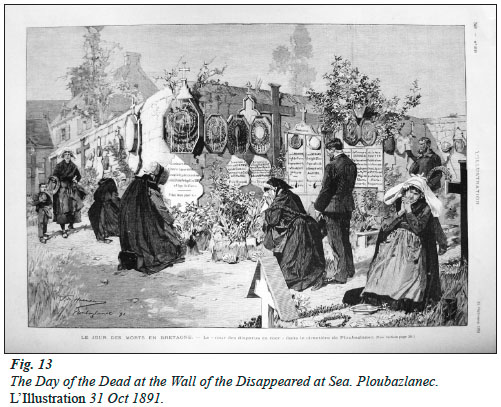
Display large image of Figure
13
References
Anson, Peter Frederick. 1965. Fisher Folk-lore; Old Customs, Taboos and Superstitions Among Fisher Folk, Especially in Brittany and Normandy and on the East Coast of Scotland. London: Faith Press.
Ardouin-Dumazet, Victor-Eugène. 1895. Voyage en France. 4ème série. Les îles de l’Atlantique (II) De Hoëdic à Ouessant. Paris: Berger-Levrault.
Badone, Ellen. 1989. The Appointed Hour: Death, Worldview and Social Change in Brittany. Berkeley and Los Angeles: University of California Press.
Belk, Russell et al. 1988. Collectors and Collecting. In Advances in Consumer Research Volume 15, ed. Micheal J. Houston, 548-53. Provo, UT : Association for Consumer Research.
Bhabha, Homi K. 1994. The Location of Culture. London: Routledge.
Blockley, Marion. 1999. Archaeological Reconstructions and the Community in the UK. In The Constructed Past: Experimental Archaeology, Education, and the Public, eds. Peter G. Stone and Philippe G. Planel, 15-34. London and New York: Routledge.
Cariou, André. 1988. Charles Cottet et la Bretagne. Douarnenez: Le Chasse Marée.
Cariou, André and Phillippe Le Stum. 1997. Pardons et pèlerinages de Bretagne. Rennes: Ouest-France.
de Certeau, Michel. 1984. The Practice of Everyday Life. Berkeley and Los Angeles: University of California Press.
Corsane, Gerard. 2005. Heritage, Museums and Galleries: An Introductory Reader. London: Routledge.
Coughlin, Maura. 2009. Crosses, Cloaks and Globes: Women’s Material Culture of Mourning on the Brittany Coast. In Women and Things: Gendered Material Practices, 1750-1950, eds. Maureen Daly Goggin and Beth Fowkes Tobin, 281-98. Hants and Burlington VT: Ashgate.
Crouch, David and Luke Desforges. 2003. The Sensuous in the Tourist Encounter. Tourist Studies 3 (1): 253-70.
Dant, Tim. 1999. Material Culture in the Social World: Values, Activities, Lifestyles. Buckingham and Philadelphia: Open University Press.
Davis, Peter. 1999. Ecomuseums: A Sense of Place. Leicester: Leicester University Press.
———. 2005. Places, ‘Cultural Touchstones’ and the Ecomuseum. In Heritage, Museums and Galleries: An Introductory Reader, ed. Gerard Corsane, 365-76. London: Routledge.
Debary, Octave and Laurier Turgeon (collectif sous la dir. de.). 2007. Objets et Mémoires. Paris et Québec: Éditions de la Maison des Sciences de l’Homme et Presses de l’Université Laval.
DeRoo, Rebecca J. 2004. Christian Boltanski’s Memory Images: Remaking French Museums in the Aftermath of ‘68. Oxford Art Journal 27 (2): 219-38.
Edensor, Tim. 2000. Staging Tourism: Tourists as Performers. Annals of Tourism Research 7 (2): 322-44.
Flaubert, Gustave. 1904. The Complete Works of Gustave Flaubert. New York and London: M. W. Dunne.
Ford, Caroline. 1990. Religion and the Politics of Cultural Change in Provincial France: The Resistance of 1902 in Lower Brittany. The Journal of Modern History 62 (1): 1-33.
Geary, Patrick J. 1995. Living with the Dead in the Middle Ages. Ithaca: Cornell University Press.
Geffroy, Gustave. 1900. La Vie Artistique. Vol. 6. Paris: Floury.
Harrison, Julia D. 2005. Ideas of Museums in the 1990s. In Heritage, Museums and Galleries: An Introductory Reader, ed. Gerard Corsane, 38-53. London: Routledge.
Heron, Paul. 1991. Ecomuseums: A New Museology. Alberta Museums Review 17 (2): 8-11.
Kaufman, Suzanne K. 2005. Consuming Visions: Mass Culture and the Lourdes Shrine. Ithaca: Cornell University Press.
Kselman, Thomas A. 2006. Death and Afterlife in Modern France. Princeton: Princeton University Press.
Massey, Doreen. 1991. A Global Sense of Place. Marxism Today 35:24-29.
McDowell, Linda. 1999. Gender, Identity and Place: Understanding Feminist Geographies. Minneapolis: University of Minnesota Press.
Nochlin, Linda. 1971. Realism. New York: Pelican.
Péron, Françoise. 1994. Ouessant. Rennes: Ouest-France.
———. 1997. Ouessant, l’île Sentinelle: Vie et Traditions d’une Île Bretonne. Douarnenez: Le Chasse-Marée.
Ploubazlanec, Bourg (le). 2008. Collections du musée ‘Mémoire d’Islande’ http://archives.cotesdarmor.fr/asp/inventaire/ ploubazlanec/Geoviewer/Data/HTML/IM22005802.html (accessed September 12, 2010).
Pocius, Gerald. 1979. Holy Pictures in Newfoundland Houses: Visual Codes for Secular and Supernatural Relationships. Laurentian University Review 12 (1): 101-25.
Poulot, Dominique. 1994. Identity as Self-Discovery: the Ecomuseum in France. In Museum Culture: Histories, Discourses, Spectacles, eds. Daniel J. Sherman and Irit Rogoff, 66-84. Minneapolis: University of Minnesota Press.
Rivard, René. 1984. Opening up the Museum, or, Towards a New Museology: Ecomuseums and ‘Open’ Museums. Quebec: Self-published.
Robinson, Marilynne. 1980. Housekeeping. New York: Farrar Straus Giroux.
Simon, J. F. 1997. La cheminée dans la maison bretonne. In Hauts lieux du sacré en Bretagne, eds. Gaël Milin and Patrick Galliou, 257-70. Brest: Centre de Recherche Bretonne et Celtique.
Simon-Hamel, Jeanne-Yvonne, Anne-Marie Le Bayon, and Michel Clément. 2001. Regards de pein tres autour de Ploumanc’h. France: Musée De Saint Brieuc.
Stewart, Susan. 1984. On Longing: Narratives of the Miniature, the Gigantic, the Souvenir, the Collection. Baltimore: John Hopkins University Press.
Young, Patrick. 2009. Fashioning Heritage: Regional Costume and Tourism in Brittany, 1890-1937. Journal of Social History 42 (3): 631-56.
Notes
- placer l’art au cœur de la vie rurale par le biais de rencontres entre la population et un artiste, rencontre élargie ici du fait de l’origine étrangère de l’artiste.
- permettre à la population de remonter le fil de son histoire.
- sensibiliser à l’art contemporain un public varié.
- permettre à un artiste étranger de renouveler son art en se familiarisant avec une autre culture.
